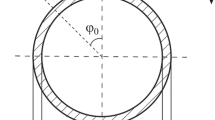Abstract—
A one-dimensional differential model describing condensation of a vapor–gas mixture in tubes and its implementation on a computer in the Visual Basic integrated development environment is presented. The model is intended for studying the operation conditions and parameters of the relevant types of condensing devices and, in the future, for carrying out technical computations and providing information support to design developments and tests. The compute kernel is based on mathematical models that take into account the main significant effects during condensation, such as gravitation (with different tube orientations), friction at the phase interface boundary (taking into account the cross flow of mass and specific roughness of the boundary), availability of noncondensing, admixtures, different external cooling methods, and the possibility of dangerous operation conditions to occur (freezing and flooding). The well-studied limiting models, such as a gravity or shear condensate film, are united by the interpolation method between asymptotes. The mathematical formulation of the problem consists of conservation equations (of momentum, energy, and mass of mixture components) for averaged flows of coolants supplemented with algebraic relations for local coefficients of heat transfer, mass transfer, and friction at the interface boundaries. The remoteness of working fluid thermodynamic parameters from the critical point, which is almost always observed in condensing installations, is the natural limitation of the analysis model’s application field. A special analysis for determining heat transfer and friction in gravity–shear condensate films based on an adequate differential turbulence model is carried out.





Similar content being viewed by others
Notes
Here and henceforth, the notation of variables is given in accordance with the computer program.
REFERENCES
V. P. Isachenko, Heat Transfer in Condensation (Energoizdat, Moscow, 1977) [in Russian].
G. F. De Santi and F. Mayinger, “Steam condensation and liquid holdup in steam generator U-tubes during oscillatory natural circulation,” Exp. Heat Transfer 6, 367–387 (1993).
A. S. Sedlov, A. P. Solodov, and D. Yu. Bukhonov, “Condensate production from exhaust flue gases at the experimental unit of PJSC ‘GRES-24’,” Energosberezhenie Vodopodgot., No. 5, 76–77 (2006).
A. V. Zheltoukhov, G. S. Taranov, M. B. Mal’tsev, and A. P. Solodov, “Calculation of the process of steam condensation from the vapor-gas mixture in the tubing of the VVER steam generator during SPOT operation,” Sb. Tr. OAO Atomenergoproekt, No. 11, 9–15. http:// www.gidropress.podolsk.ru/files/proceedings/mntk2011/ autorun/section3-ru.htm (2011).
J. Huhn, “Filmstroemungen bei sich ueberlagernden Einfluessen,” Waerme- Stoffuebertrag. 19, 133–144 (1985).
A. P. Solodov, D. V. Sidenkov, and I. I. Kutakov, “Physical and mathematical model, algorithm and program for computation of heat mass transfer and resistance in steam condensation in inclined tubes,” in Proc. Engineering Foundation Conf. on Condensation and Condenser Design, St. Augustine, FL, March 7–12, 1993 (Am. Soc. Mech. Eng., New York, 1993), pp. 569–580.
A. P. Solodov, “Differential model of heat and mass exchanger,” Teplovye Protsessy v Tekh., No. 8, 364–370 (2010).
D. A. Labuntsov, Physical Fundamentals of Power Engineering. Selected Papers on Heat Transfer, Hydrodynamics and Thermodynamics (Mosk. Energ. Inst., Moscow, 2000), pp. 177–197 [in Russian].
G. B. Wallis, One-Dimensional Two-Phase Flow (McGraw-Hill, New York, 1969).
R. Numrich, Die Partielle Kondensation Eines Wasserdampf/Luftgemisches im Senkrechten Rohr bei Drücken bis 21 Bar, Dissertation (Univ. Paderborn, Paderborn, 1988); VDI Fortschritt-Berichte, Reihe 3, No. 165.
M. Rahman, M. Lampinen, and T. Siikonen, “An improved k-equation turbulence model,” Int. J. Energy Power Eng., No. 8, 1895–1907 (2014).
A. P. Solodov, “Phase interface perturbations in phase transitions,” High. Temp. 55, 253–262 (2017). https://doi.org/10.1134/S0018151X17020195
Author information
Authors and Affiliations
Corresponding author
Additional information
Translated by V. Filatov
Rights and permissions
About this article
Cite this article
Gorpinyak, M.S., Solodov, A.P. Vapor–Gas Mixture Condensation in Tubes. Therm. Eng. 66, 388–396 (2019). https://doi.org/10.1134/S004060151906003X
Received:
Revised:
Accepted:
Published:
Issue Date:
DOI: https://doi.org/10.1134/S004060151906003X




